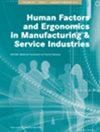Evaluating the Impact of Mind-Wandering on Driller's Situation Awareness Using Wearable Eye-Tracking Technology
Abstract
Drilling accidents often occur due to inadequate situational awareness of drilling workers. The prolonged and tedious monitoring of drilling parameters may result in drilling workers experiencing mind-wandering. To explore this problem, this study employed wearable eye tracking technology to assess the mind-wandering status of drilling workers during work finishing (WF) and investigate the influence of mind-wandering on the situational awareness of these workers. A simulation of monitoring drilling parameters was conducted in the laboratory by 18 drillers, who were asked to fill out situational awareness questionnaires using the global assessment of situational awareness (SAGAT) and had their behavioral and eye movement data collected during the task. The eye movement results revealed that drilling workers experienced mind-wandering during the WF, as evidenced by a significant increase in fixation duration and count, along with a decrease in pupil diameter. This led to a decrease in situational awareness scores and a notable increase in reaction times, indicating that mind-wandering had an impact on the situational awareness of drilling workers. In addition, the eye movement areas of interest (AOIs) were further analyzed to explore drilling worker attention allocation. This study showcases the potential of using wearable eye-tracking technology to identify mind-wandering in drilling workers who are responsible for monitoring drilling parameters. By gaining a deeper insight into the eye movement patterns associated with mind-wandering in drilling workers, we can establish a strong basis for creating interventions that enhance their situational awareness.

 求助内容:
求助内容: 应助结果提醒方式:
应助结果提醒方式:


